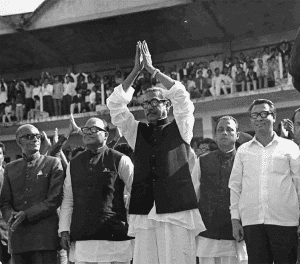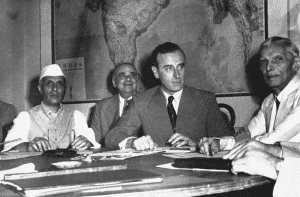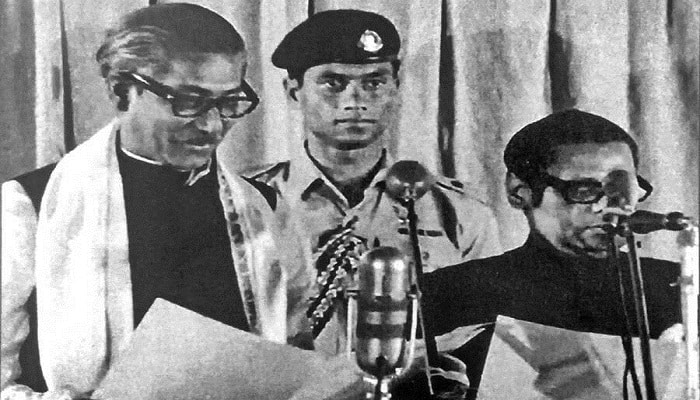PNN – Bangladesh Prime Minister Sheikh Hasina’s flight from the country following widespread protests in Dhaka has coincided with the anniversary of the coup against her father in 1975; When Sheikh Mujibur Rahman, the founder of Bangladesh, was killed by the military. Also, this week marks the anniversary of the formation of the terrorist organization Al-Qaeda and the anniversary of the Taliban gaining power in Afghanistan.
According to the report of Pakistan News Network, history always provides us with clues to know and better understand what is happening today. The twists and turns of history have been changed by small and large events over time, and every event has been influential in shaping the current geopolitical situation. Asia and the Pacific, which has a significant share of the size of this globe, has gone through important and influential changes like other parts of the world.
In this report, we are trying to provide the audience with some clues about how the policies and geography of the Asia-Pacific region are formed today, with a description of several historical events in the period from August 10 to 16 (this week).
1975 coup against Sheikh Mujibur Rahman in Bangladesh
On August 15, 1975, nearly 4 years after the country’s separation from Pakistan, the army officers in Bangladesh staged a coup against the founder and first president, Sheikh Mujibur Rahman. During a conspiracy, army officers killed Sheikh Mujibur Rahman and most of his family members, except for his two daughters, Sheikh Hasina and Sheikh Rehana, who were traveling in Europe. Some, including Lawrence Lifsholtz, an American journalist, believe that Sheikh Mujib’s plans had caused concern for the Americans and that the coup was probably carried out with the help of the Central Intelligence Agency (CIA). Lifscholtz says that Philip Cherry, the head of the CIA base in Dhaka, was actively involved in the coup.

Mujibur Rehman declared independence from Pakistan on March 26, 1971, which led to the 9-month war of independence of Bangladesh. A peace treaty was signed on July 2, 1972, a few months after the surrender of Pakistan’s Eastern Command forces in the 1971 war. Pakistan finally recognized the existence of Bangladesh in February 1974.
Meanwhile, Sheikh Hasina, his eldest daughter, fled the country and went to India after 15 years in power. After the fall of Sheikh Hasina’s government, protesters pulled down the statue of Mujibur Rahman, her father. New Delhi was one of the staunch supporters of Mujibur Rahman in Bangladesh’s war of independence against Pakistan.
Independence of Pakistan and India from British rule
The Indian subcontinent was freed from British colonial rule in 1947. The British, whose colonial presence in the vast region of the Indian subcontinent dates back to 1600 AD, were able to complete their domination over this region in 1857 AD. About a century later and after the Second World War, England, which had lost most of its power, was forced to end its colonial presence in the subcontinent in 1947.
August 14 and 15, 1947 is the anniversary of the separation of Pakistan and India, and these two countries celebrate this independence every year on this date during a ceremony called “Independence Day”. But the destructive effects of the presence of the British in the subcontinent region, including the severe territorial and political differences between India and Pakistan, and the backwardness and insecurity of Pakistan today, as an old and unhealed wound on its body, are still clearly felt as the legacy of the British in this region.

On August 14, 1947, under the leadership of Muhammad Ali Jinnah, known as Quaid-e-Azam, the founder of this country, Pakistan was freed from the colonialism of the British government at the time, and declared its existence as a separate country centered in the city of Karachi. That day, Quaid-e-Azam said in a speech: Finally, after a decade of efforts, Pakistan was formed today by the will of Almighty God, the purpose of which is to create a country for Muslims so that they can shape their lives according to their wishes and according to Islamic culture and civilization.
Jawaharlal Nehru announced the independence of India on August 15, 1947 in his famous speech. India later became an independent country and Jawaharlal Nehru was appointed as its first Prime Minister and British King Mountbatten’s representative in India remained as the country’s first Governor General. In its 72-year history, based on the ideas of Mahatma Gandhi and Jawaharlal Nehru, India was able to emerge as an independent and powerful country in Asia.
Afghanistan; The anniversary of the formation of al-Qaeda and the anniversary of the Taliban coming to power
On August 11, 1988, Al-Qaeda was formed in a meeting attended by Osama bin Laden, Ayman al-Zawahiri and Dr. Fazal in Peshawar, Pakistan. The name of al-Qaeda is derived from the name of the first military base of this organization “Al-Qaeda al-Jihad”. Of course, most of the members initially called this organization “International Front of Jihad against Jews and Crusaders”. In this regard, Al-Qaeda was founded in 1988 by the Saudi billionaire Osama Bin Laden to fight against the Soviet Union in Afghanistan. The formation of forces to fight against the Soviets led to the cooperation of al-Qaeda with internal groups, including the Taliban.

Al-Qaeda has carried out attacks against civilian and military targets in various countries, which, according to the Americans, include the 1998 bombings of American embassies in African countries and the September 11 attacks. In response to the 9/11 attacks, the United States invaded Afghanistan under Taliban rule, seeking to weaken bin Laden and his allies. The death of key leaders, including Osama bin Laden, changed the direction of al-Qaeda’s operations from a top-down organization and planning attacks to planning attacks through affiliate groups.
America was present in Afghanistan for two decades, and finally in 2021, it withdrew all its forces, and the President of Afghanistan, Ashraf Ghani, also fled the country. This issue led to the reinstatement of the Taliban, who took power in this country on August 15 and has been trying to form an inclusive government for three years now. With the presence of the Taliban at the head of Afghanistan’s governance, it is said in official circles and the comments of the country’s officials that they are still in contact with Al-Qaeda and provide a safe haven for other terrorist elements.
Treaty of Peace and Friendship between Japan and China
The Treaty of Peace and Friendship between Japan and the People’s Republic of China was signed six years after the normalization of diplomatic relations between the two countries on August 12, 1978, and came into force on October 23 of the same year. The two countries had a history of long-term wars with each other. The last of those conflicts was during World War II, which took place between July 7, 1937 and September 9, 1945. With the Japanese attack on Pearl Harbor in 1941, the war between the Republic of China and the Empire of Japan became part of World War II on the Pacific front.
However, some consider the second war between China and Japan to be the beginning of World War II, but most historians and researchers believe that World War II began in September 1939 with Germany’s attack on Poland. The war between China and the Japanese Empire was the largest war in Asia in the 20th century, resulting in half of the casualties of the Pacific War. This war finally ended with the surrender of the Japanese Empire to the Allies in World War II.
In the current situation, there is also a potential flash point in the East Asia region, especially in the important waterway of the South China Sea, which is caused by tensions between China and the Philippines. Also, currently, South Korea and Japan, as US allies, are worried about China’s forward movement and the increase of North Korea’s nuclear capabilities.

